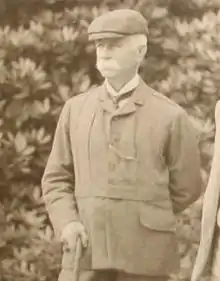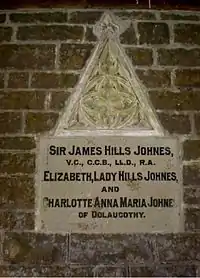Sir James Hills-Johnes | |
|---|---|
 Sir James Hills-Johnes c. 1900s | |
| Birth name | James Hills |
| Nickname(s) | Jemmy[1] |
| Born | 20 August 1833 Neechindipur, British India |
| Died | 3 January 1919 (aged 85) Dolaucothi Estate, Carmarthenshire, Wales |
| Buried | |
| Allegiance | United Kingdom |
| Service/ | Bengal Army British Indian Army |
| Years of service | 1853–1888 |
| Rank | Lieutenant General |
| Unit | Bengal Horse Artillery Royal Artillery |
| Commands held | 3rd Division, Northern Afghanistan Field Force Military Governor of Kabul Kohat District Peshawar Mountain Battery |
| Battles/wars | Indian Mutiny Abyssinian War Lushai Expedition Second Anglo-Afghan War |
| Awards | Victoria Cross Knight Grand Cross of the Order of the Bath Mentioned in Despatches (4) |
| Relations | William George Cubitt VC (brother-in-law) Lewis Pugh Evans VC (nephew) |
Lieutenant General Sir James Hills-Johnes, VC, GCB (20 August 1833 – 3 January 1919) was a British Indian Army officer and a recipient of the Victoria Cross, the highest award for gallantry in the face of the enemy that can be awarded to British and Commonwealth forces.
Early life
Born James Hills on 20 August 1833 in Neechindipur, Bengal, India, he was the son of James and Charlotte Hills. He was educated at the Edinburgh Academy (1843–1847), the Edinburgh Institution (1847–1850) and the Addiscombe Military Seminary (1851–1853), and was commissioned into the Bengal Artillery in 1853. Hills changed his surname to Hills-Johnes in 1882 on his marriage to Elizabeth Johnes, the younger daughter and coheiress of John Johnes of Dolaucothi, Carmarthenshire.[1]
Military career
.jpg.webp)
Hills was a 23 years old second lieutenant in the Bengal Horse Artillery during the Indian Mutiny when the following deed took place at the Siege of Delhi on 9 July 1857 for which he and Henry Tombs were awarded the Victoria Cross:
Lieutenant-Colonel Henry Tombs, C.B., and Lieutenant James Hills
Date of Act of Bravery, 9 July 1857
For very gallant conduct on the part of Lieutenant Hills before Delhi, in defending the position assigned to him in case of alarm, and for noble behaviour on the part of Lieutenant-Colonel Tombs in twice coming to his subaltern's rescue, and on each occasion killing his man. (See despatch of Lieutenant-Colonel Mackenzie, Commanding 1st Brigade Horse Artillery, dated Camp, near Delhi, 10 July 1857,
published in the Supplement to the London Gazette of 16 January 1858.)[2]
In addition to the Delhi clasp of the Indian Mutiny Medal, Hills received the Lucknow clasp awarded to troops under command of Sir Colin Campbell who were engaged in final operations leading to the surrender of Lucknow and the clearing of the surrounding areas from November 1857 to March 1858.
After a number of staff appointments, Hills served as an artillery officer in the Abyssinian campaign of 1867–68 and the Lushai Expedition of 1871–72. Promoted major-general in July 1879, he fought in the Second Anglo-Afghan War (1878–80), and was made military governor of Kabul in October 1879 and commanded a division in 1880.[1] For services in Afghanistan he was appointed Knight Commander of the Order of the Bath (KCB) in March 1881.[3] Hills-Johnes was promoted lieutenant-general in January 1884[4] and retired in 1888.[1] He was made a Knight Grand Cross of the Order of the Bath (GCB) in June 1893.[5]
Later life

Hills-Johnes was High Sheriff of Carmarthenshire in 1886 and made an honorary freeman of the town of Carmarthen in 1910. He also served as a member of Carmarthenshire County Council.[1] He was appointed Honorary Colonel of the Royal Carmarthen Artillery, the local Militia unit, on 25 February 1891.[6] He was a long standing friend of Lord Roberts, and in 1900 he accompanied Roberts in a private capacity during the South African War.[1]
He died of influenza during the post-war pandemic on 3 January 1919, aged 85, at his Dolaucothi Estate and was buried at Caio, Carmarthenshire.[1]
Hills-Johnes had five brothers and four sisters. The brothers included Major-General Sir John Hills (1834–1902) of the Bombay Engineers;[1] Robert Hills (1837–1909), a first-class cricketer who was the brother-in-law of Lieutenant William George Cubitt VC and uncle of Brigadier Lewis Pugh Evans VC; and Charles Hills (1847–1935), the family history saying he was the real father of Hollywood actress Merle Oberon.[7]
His medals, including the Victoria Cross, are displayed at the Royal Artillery Museum, Woolwich, London.[8]
References
- 1 2 3 4 5 6 7 8 Vetch, R.H.; Revised by: Stearn, Roger T. "Johnes-Hills, Sir James (on page of: Hills, Sir John)". Oxford Dictionary of National Biography. ISBN 019861411X. Retrieved 8 September 2021.
- ↑ "No. 22131". The London Gazette. 27 April 1858. p. 2050.
- ↑ "No. 24944". The London Gazette. 1 March 1881. p. 975.
- ↑ "No. 25312". The London Gazette. 25 January 1884. p. 380.
- ↑ "No. 26409". The London Gazette. 3 June 1893. p. 3251.
- ↑ Army List.
- ↑ MacNair, Miles (2013). Indigo & Opium: two remarkable families and fortunes won and lost. Studley: Brewin Books. ISBN 9781858585178.
- ↑ "VC locations: victoriacross.org.uk". Retrieved 10 September 2021.
Further reading
- Vetch, R. H.; Stearn, Roger T. (reviewer) (2011) [2004]. "Hills, Sir John (1834–1902)". Oxford Dictionary of National Biography (online ed.). Oxford University Press. doi:10.1093/ref:odnb/33877. (Subscription or UK public library membership required.) (includes details of Sir James Hills-Johnes)
- Vibart, H. M. (1894). Addiscombe: its heroes and men of note. Westminster: Archibald Constable. pp. 608–13. OL 23336661M.